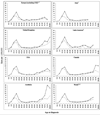International osteosarcoma incidence patterns in children and adolescents, middle ages and elderly persons
- PMID: 19330840
- PMCID: PMC3048853
- DOI: 10.1002/ijc.24320
International osteosarcoma incidence patterns in children and adolescents, middle ages and elderly persons
Abstract
Osteosarcoma incidence rates in the United States peak in adolescence and in the elderly. The international patterns of osteosarcoma incidence in children have been described, whereas those for young, middle age or elderly adults have not. Using the Cancer Incidence in Five Continents, International Agency for Cancer Research database we compared incidence rates for children and adolescents (age 0-24 years), the middle age group (25-59 years) and elderly (>or=60 years) persons by world regions and individual countries. Overall, worldwide osteosarcoma incidence rates were quite similar in the younger age groups. The greatest variation in incidence rates was observed in the elderly.
Figures

Similar articles
-
International trends in incidence of osteosarcoma (1988-2012).Int J Cancer. 2021 Sep 1;149(5):1044-1053. doi: 10.1002/ijc.33673. Epub 2021 May 17. Int J Cancer. 2021. PMID: 33963769 Free PMC article.
-
Osteosarcoma incidence and survival rates from 1973 to 2004: data from the Surveillance, Epidemiology, and End Results Program.Cancer. 2009 Apr 1;115(7):1531-43. doi: 10.1002/cncr.24121. Cancer. 2009. PMID: 19197972 Free PMC article.
-
Descriptive epidemiology of malignant primary osteosarcoma using population-based registries, United States, 1999-2008.J Registry Manag. 2013 Summer;40(2):59-64. J Registry Manag. 2013. PMID: 24002129 Free PMC article.
-
The epidemiology of osteosarcoma.Cancer Treat Res. 2009;152:3-13. doi: 10.1007/978-1-4419-0284-9_1. Cancer Treat Res. 2009. PMID: 20213383 Review.
-
[Epidemiologic review of bone cancers and more particularly osteosarcoma].Chir Pediatr. 1985;26(4):207-12. Chir Pediatr. 1985. PMID: 3907869 Review. French. No abstract available.
Cited by
-
Determination of VEGF165 using impedimetric aptasensor based on cyclohexanehexone-melem covalent-organic framework.Mikrochim Acta. 2021 May 28;188(6):211. doi: 10.1007/s00604-021-04843-9. Mikrochim Acta. 2021. PMID: 34050442
-
Comprehensive analysis of prognostic tumor microenvironment-related genes in osteosarcoma patients.BMC Cancer. 2020 Aug 27;20(1):814. doi: 10.1186/s12885-020-07216-2. BMC Cancer. 2020. PMID: 32854645 Free PMC article.
-
Children's Oncology Group's 2013 blueprint for research: bone tumors.Pediatr Blood Cancer. 2013 Jun;60(6):1009-15. doi: 10.1002/pbc.24429. Epub 2012 Dec 19. Pediatr Blood Cancer. 2013. PMID: 23255238 Free PMC article. Review.
-
Augmenting L3MBTL2-induced condensates suppresses tumor growth in osteosarcoma.Sci Adv. 2023 Nov 24;9(47):eadi0889. doi: 10.1126/sciadv.adi0889. Epub 2023 Nov 22. Sci Adv. 2023. PMID: 37992172 Free PMC article.
-
Development and characterization of the novel human osteosarcoma cell line COS-33 with sustained activation of the mTOR pathway.Oncotarget. 2020 Jul 7;11(27):2597-2610. doi: 10.18632/oncotarget.27611. eCollection 2020 Jul 7. Oncotarget. 2020. PMID: 32676162 Free PMC article.
References
-
- Dorfman HA, Czerniak B. Bone Cancers. Cancer supplement. 1995;75:203–210. - PubMed
-
- Cancer facts and figures 2008. Atlanta: American Cancer Society Inc.; 2008.
-
- Gurney JG, Swensen AR, Bulterys M. Malignant bone tumors. In: Reis LAG Smith MA, Gurney JG, Linet M, Tamra T, Young JL, Bunin GR, editors. Cancer Incidence and Survival Among Children and Adolescents: United States SEER Program, 1975–1995. Bethesda, MD: National Cancer Institute; 1999. pp. 99–110. NIH Pub. No. 99-4649.
-
- Mascarenhas L, Siegel S, Spector L, Arndt C, Femino D, Malogolowkin M. Malignant bone tumors: cancer in 15- to 29-year-olds in the United States. In: Bleyer A, O'Leary M, Barr R, Ries LAG, editors. Cancer Epidemiology in older adolescents and young adults 15 to 29 years of age, including SEER incidence and survival: 1975–2000. Bethesda, MD: National Cancer Institute; 2006. pp. 98–109. NIH Pub. No. 06-5767.
-
- Parkin DM, Kramárová E, Draper GJ, Masuyer E, Michaelis J, Neglia J, Qureshi S, Stiller CA. IARC Scientific Publications No. 144. vol. 2. Lyon: 1998. International incidence of childhood cancer.
Publication types
MeSH terms
Grants and funding
LinkOut - more resources
Full Text Sources
Other Literature Sources
Medical

